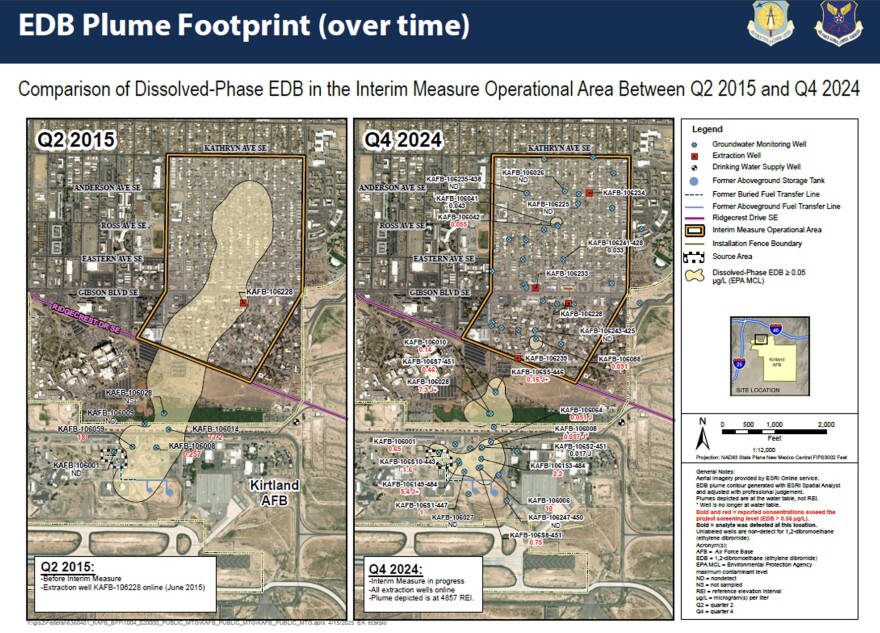Jet fuel leaking from Kirtland Air Force base into the ground beneath Albuquerque was first discovered nearly 26 years ago in November 1999. So some residents may be surprised that the cleanup process has yet to begin in earnest. While some interim measures have been taken to stop the fuel from getting into the city’s drinking water, experts told lawmakers Tuesday that only the first phase of the process, the investigation, is finally nearing completion.
At a presentation to the legislative Military and Veterans’ Affairs Committee, Environmental Manager for the Albuquerque Bernalillo County Water Utility Authority, Kelsey Bicknell said the fuel plume’s cleanup is governed by the Federal Resource Conservation and Recovery Act, which dictates a multi-phase process.
After the investigation, the next step is counter measure evaluations, during which the Air Force, along with the New Mexico Environment Department and the water authority review the plan for the cleanup before actually implementing the steps.
That’s not to say nothing has been done in the last quarter century. In fact, interim measures like soil vapor extraction and groundwater pump and treat systems have reduced contamination, and prevented chemicals from mixing with the city’s drinking water. While those measures have been successful, Bicknell said if the cleanup were to continue as is, it wouldn’t be complete for generations.
“Our modeling estimates that we're looking at about 100 years to clean up the site, and that's a long time,” she said. “And then if we were just to say, ‘we'll turn everything off and just kind of let nature run its course,’ we're looking at several centuries for cleanup, and so in either case, this is a very long time.”

Physical Scientist with Kirtland, Ryan Wortman, said the cleanup has been and will be focused mainly on two major contaminants — ethylene dibromide, or EDB, and benzene. The interim measures have already been able to clean up 95% of the EDB plume, but the benzene plume has actually grown slightly bigger.
Wortman said that’s because aquifer levels have been rising since their low in 2009, when the San Juan – Chama Diversion Project allowed the water authority to start relying more on surface water and less on groundwater. During the same time, soil vapor extraction removed loose fuel above the aquifer, but some contaminants that were absorbed by the soil were left behind.
As the aquifer has risen, it has reached more soil, and benzene has been spreading as a result. However, benzene doesn’t flow with the water the same way EDB does, which makes it more likely to stay in one area, thereby avoiding drinking water supply wells.
“The stability of the plume is mainly what we're looking at. It's not migrating towards anywhere. It's expanding out in all directions due to contacting additional fuel contaminant,” Wortman said, “and we're really keeping our eye on if that starts moving in any sort of direction towards a drinking water supply well.”
Bicknell reassured lawmakers the water authority monitors the drinking water supply wells monthly for any sort of contamination, and says the fuel plume has not reached areas where those wells are pulling water. She said they have a policy in place to shut off wells if any contaminants are detected.
“That well would be turned off,” she said. “We would not serve that water to our customers.”
When State Sen. Jay Block (R-Rio Rancho) asked the panel why the investigation phase has taken so long, Wortman pointed out the in-depth investigation and amount of data uncovered contributed to the successful EDB cleanup.
“Over a quarter of a century long project, there's a lot of answers for why the delays happened. I would summarize it with the first 15 years really being we needed to understand the extent of the problem,” he said. “We did not have a full picture of this site for the first 15 years. However, that long time of investigating delineation has resulted in that successful interim measure.”
In order to expedite the process going forward, Wortman said building off of regulatory approvals, as well as evaluations and data that have already been established, deliberated and on which consensus has been reached will be key. That will save time by avoiding further yearslong debates. Even with that, however, he expects the process won’t be concluded anytime soon.
“Obviously we want to expedite cleanup,” Wortman said. “But 25 years is what we've experienced for a site of this scale so far, and we're anticipating additional efforts going out at least several decades into the future.”
Chief of the Hazardous Waste Bureau for the Environment Department, John-David Nance, said NMED is working with contractors to help spread out the work to be more efficient, and has been hiring more employees as well.
“This has gone on for a long time,” Nance said. “We're really trying to make sure that we can get our part done to keep the process moving forward.”
Wortman said the entire process is open to public input, with documents available on their administrative records website, and information about the process so far available online.
“This is a part of the process where we really weigh in the entire community's perspective and ensure, when we go out and put those taxpayer dollars,” he said, “that those go directly towards remedial strategies that will achieve the in-state goals of the community, as well as the regulatory agency in charge of this project.”
Kirtland will be hosting an open house of the Bulk Fuels Facility Thursday July 17 from 5:00 until 7:00 p.m. where the public can get a tour, and information on the base’s latest efforts to fight the contamination.
Support for this coverage comes from the W.K. Kellogg Foundation.




